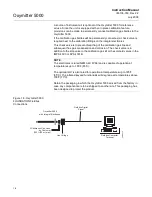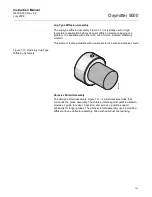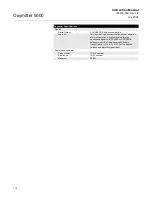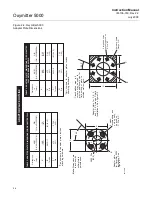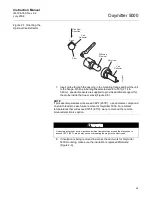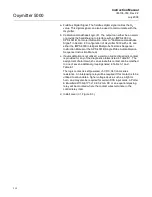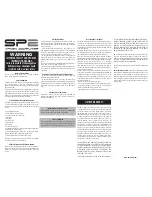
Oxymitter 5000
2-2
Instruction Manual
IM-106-350, Rev 2.2
July 2008
MECHANICAL
INSTALLATION
Selecting Location
1. The location of the Oxymitter 5000 in the stack or flue is most important
for maximum accuracy in the oxygen analyzing process. The Oxymitter
5000 must be positioned so the gas it measures is representative of the
process. Best results are normally obtained if the Oxymitter 5000 is
positioned near the center of the duct (40-60% insertion). Longer ducts
may require several Oxymitter 5000 units since the O
2
can vary due to
stratification. A point too near the wall of the duct, or the inside radius of
a bend, may not provide a representative sample because of the very
low flow conditions. The sensing point should be selected so the
process gas temperature falls within a range of 32° to 1300°F
(0° to 704°C). Figure 2-1 through Figure 2-9 provide mechanical
installation references. The ambient temperature of the integral
electronics housing must not exceed 185°F (85°C). F or higher ambient
temperatures, we recommend the remote mounted electronics option.
2. Check the flue or stack for holes and air leakage. The presence of this
condition will substantially affect the accuracy of the oxygen reading.
Therefore, either make the necessary repairs or install the Oxymitter
5000 upstream of any leakage.
3. Ensure the area is clear of internal and external obstructions that will
interfere with installation and maintenance access to the membrane
keypad or LOI. Allow adequate clearance for removal of the Oxymitter
5000.
Probe Installation
1. Ensure all components are available to install the Oxymitter 5000. If
equipped with the optional ceramic diffusion element, ensure it is not
damaged.
2. The Oxymitter 5000 may be installed in tact as it is received.
NOTE
An abrasive shield is recommended for high velocity particulates in the flue
stream (such as those in coal-fired boilers, kilns, and recovery boilers).
Vertical and horizontal brace clamps are provided for 9 ft and 12 ft (2,75 m
and 3,66 m) probes to provide mechanical support for the Oxymitter 5000.
Refer to Figure 2-6.
3. Weld or bolt adapter plate (Figure 2-5) onto the duct.
4. If using the optional ceramic diffusion element, the vee deflector must
be correctly oriented. Before inserting the Oxymitter 5000, check the
direction of gas flow in the duct. Orient the vee deflector so the apex
points upstream toward the flow (Figure 2-7). This may be done by
loosening the setscrews and rotating the vee deflector to the desired
position. Retighten the setscrews.
Do not allow the temperature of the Oxymitter 5000 electronics to exceed 185°F (85°C) or
damage to the unit may result.
Summary of Contents for Oxymitter 5000
Page 2: ......
Page 6: ......
Page 12: ......
Page 22: ...Oxymitter 5000 xii Instruction Manual IM 106 350 Rev 2 2 July 2008 ...
Page 42: ...Oxymitter 5000 1 20 Instruction Manual IM 106 350 Rev 2 2 July 2008 ...
Page 62: ...Oxymitter 5000 2 20 Instruction Manual IM 106 350 Rev 2 2 July 2008 ...
Page 74: ...Oxymitter 5000 4 6 Instruction Manual IM 106 350 Rev 2 2 July 2008 ...
Page 78: ...Oxymitter 5000 5 4 Instruction Manual IM 106 350 Rev 2 2 July 2008 ...
Page 94: ...Oxymitter 5000 7 6 Instruction Manual IM 106 350 Rev 2 2 July 2008 ...
Page 140: ...Oxymitter 5000 9 22 Instruction Manual IM 106 350 Rev 2 2 July 2008 ...
Page 184: ...Oxymitter 5000 B 2 Instruction Manual IM 106 350 Rev 2 2 July 2008 ...
Page 204: ...Oxymitter 5000 D 14 Instruction Manual IM 106 350 Rev 2 2 July 2008 ...
Page 222: ...Oxymitter 5000 E 18 Instruction Manual IM 106 350 Rev 2 2 July 2008 ...
Page 224: ...Instruction Manual IM 106 350 Rev 2 2 July 2008 Index 2 Oxymitter 5000 ...

